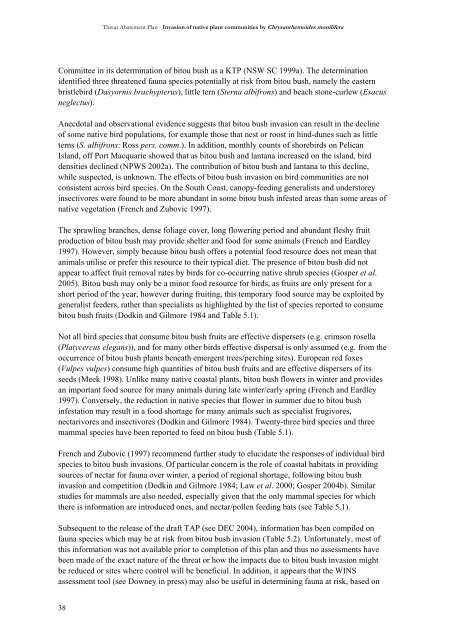NSW Bitou Bush Threat Abatement Plan - Department of ...
NSW Bitou Bush Threat Abatement Plan - Department of ...
NSW Bitou Bush Threat Abatement Plan - Department of ...
Create successful ePaper yourself
Turn your PDF publications into a flip-book with our unique Google optimized e-Paper software.
38<br />
<strong>Threat</strong> <strong>Abatement</strong> <strong>Plan</strong> - Invasion <strong>of</strong> native plant communities by Chrysanthemoides monilifera<br />
Committee in its determination <strong>of</strong> bitou bush as a KTP (<strong>NSW</strong> SC 1999a). The determination<br />
identified three threatened fauna species potentially at risk from bitou bush, namely the eastern<br />
bristlebird (Dasyornis brachypterus), little tern (Sterna albifrons) and beach stone-curlew (Esacus<br />
neglectus).<br />
Anecdotal and observational evidence suggests that bitou bush invasion can result in the decline<br />
<strong>of</strong> some native bird populations, for example those that nest or roost in hind-dunes such as little<br />
terns (S. albifrons: Ross pers. comm.). In addition, monthly counts <strong>of</strong> shorebirds on Pelican<br />
Island, <strong>of</strong>f Port Macquarie showed that as bitou bush and lantana increased on the island, bird<br />
densities declined (NPWS 2002a). The contribution <strong>of</strong> bitou bush and lantana to this decline,<br />
while suspected, is unknown. The effects <strong>of</strong> bitou bush invasion on bird communities are not<br />
consistent across bird species. On the South Coast, canopy-feeding generalists and understorey<br />
insectivores were found to be more abundant in some bitou bush infested areas than some areas <strong>of</strong><br />
native vegetation (French and Zubovic 1997).<br />
The sprawling branches, dense foliage cover, long flowering period and abundant fleshy fruit<br />
production <strong>of</strong> bitou bush may provide shelter and food for some animals (French and Eardley<br />
1997). However, simply because bitou bush <strong>of</strong>fers a potential food resource does not mean that<br />
animals utilise or prefer this resource to their typical diet. The presence <strong>of</strong> bitou bush did not<br />
appear to affect fruit removal rates by birds for co-occurring native shrub species (Gosper et al.<br />
2005). <strong>Bitou</strong> bush may only be a minor food resource for birds, as fruits are only present for a<br />
short period <strong>of</strong> the year, however during fruiting, this temporary food source may be exploited by<br />
generalist feeders, rather than specialists as highlighted by the list <strong>of</strong> species reported to consume<br />
bitou bush fruits (Dodkin and Gilmore 1984 and Table 5.1).<br />
Not all bird species that consume bitou bush fruits are effective dispersers (e.g. crimson rosella<br />
(Platycercus elegans)), and for many other birds effective dispersal is only assumed (e.g. from the<br />
occurrence <strong>of</strong> bitou bush plants beneath emergent trees/perching sites). European red foxes<br />
(Vulpes vulpes) consume high quantities <strong>of</strong> bitou bush fruits and are effective dispersers <strong>of</strong> its<br />
seeds (Meek 1998). Unlike many native coastal plants, bitou bush flowers in winter and provides<br />
an important food source for many animals during late winter/early spring (French and Eardley<br />
1997). Conversely, the reduction in native species that flower in summer due to bitou bush<br />
infestation may result in a food shortage for many animals such as specialist frugivores,<br />
nectarivores and insectivores (Dodkin and Gilmore 1984). Twenty-three bird species and three<br />
mammal species have been reported to feed on bitou bush (Table 5.1).<br />
French and Zubovic (1997) recommend further study to elucidate the responses <strong>of</strong> individual bird<br />
species to bitou bush invasions. Of particular concern is the role <strong>of</strong> coastal habitats in providing<br />
sources <strong>of</strong> nectar for fauna over winter, a period <strong>of</strong> regional shortage, following bitou bush<br />
invasion and competition (Dodkin and Gilmore 1984; Law et al. 2000; Gosper 2004b). Similar<br />
studies for mammals are also needed, especially given that the only mammal species for which<br />
there is information are introduced ones, and nectar/pollen feeding bats (see Table 5.1).<br />
Subsequent to the release <strong>of</strong> the draft TAP (see DEC 2004), information has been compiled on<br />
fauna species which may be at risk from bitou bush invasion (Table 5.2). Unfortunately, most <strong>of</strong><br />
this information was not available prior to completion <strong>of</strong> this plan and thus no assessments have<br />
been made <strong>of</strong> the exact nature <strong>of</strong> the threat or how the impacts due to bitou bush invasion might<br />
be reduced or sites where control will be beneficial. In addition, it appears that the WINS<br />
assessment tool (see Downey in press) may also be useful in determining fauna at risk, based on
















